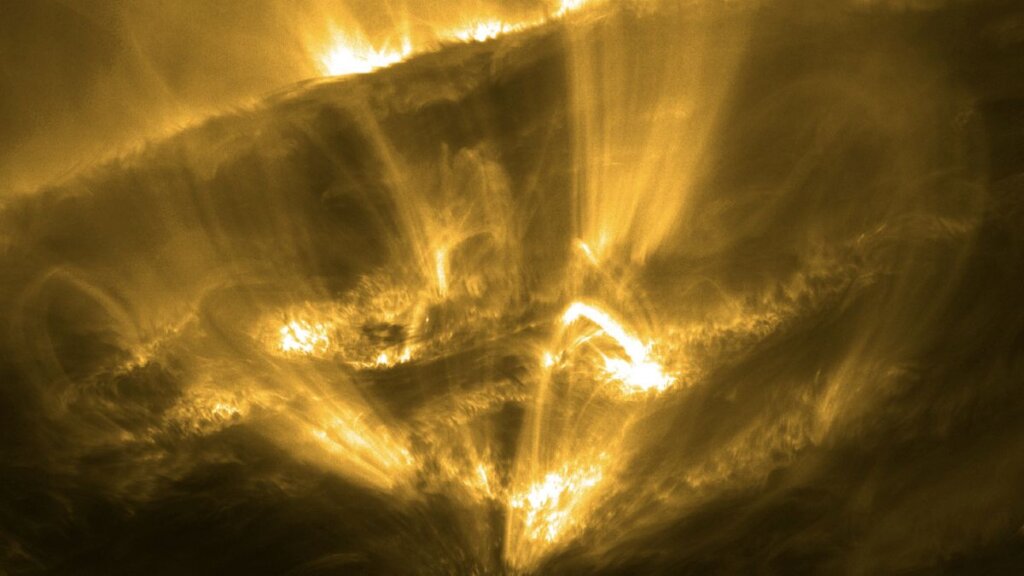
“Shooting stars” seen raining down on the sun for the first time (images) (Image Credit: Space.com)
Astronomers have spotted never-before-seen meteor-like streaks seemingly rain on the surface of the sun, but you should think twice before attempting to catch these falling stars.
“If humans were alien beings capable of living on the sun’s surface, we would constantly be rewarded with amazing views of shooting stars, but we would need to watch out for our heads!” Patrick Antolin, a solar physicist at Northumbria University in London and lead author of the discovery, said in a statement.
These solar shooting stars are quite different from shooting stars that appear over Earth, which are fragments of space dust, rock, or small asteroids that enter the atmosphere at high speeds and burn up, creating streaks of light. The solar shooting stars are giant clumps of plasma dropping to the star’s surface at incredible speeds.
On Earth, most meteors don’t make it to the surface due to the thick atmosphere of our planet, but the sun’s atmosphere — the corona — is much thinner, and thus these clumps are not completely stripped as they fall. Thus solar shooting stars could make it to our star’s surface intact.
Related: Sun breaks out with record number of sunspots, sparking solar storm concerns
This observation, made with the European Space Agency’s Solar Orbiter spacecraft, marks the first time these impacts have been spotted. The findings have revealed that this process can create short but intense brightening and both an upward surge of stellar material and shock waves that reheat the gas in the corona above the impacts.
Scientists think that this discovery could therefore help solve the mystery of why the corona, the outermost part of the sun’s atmosphere, is much hotter than the layers of the sun below it, despite solar models predicting the sun should become hotter closer to its core.
The solar shooting stars were spotted by Solar Orbiter as it observed spectacular plasma firework displays called coronal rain, formed of gas with temperatures upwards of 2 million degrees Fahrenheit.

Singeing in the rain
Rather than being composed of water, coronal rains form when localized temperature drops cause solar plasma to cluster into super-dense lumps. Reaching sizes as great as 155 miles (250 kilometers) wide, these lumps then drop to the much cooler surface of the sun, the photosphere, as a fiery rain at speeds as great as 220,000 miles per hour (100 kilometers per second).
Solar Orbiter spotted those coronal rains when it passed at a distance of just 30 million miles (49 million kilometers) from the sun, which is closer than the orbit of the solar system‘s innermost planet Mercury. The probe, fitted with high-resolution cameras and a set of sensitive remote-sensing instruments, saw that there was gas being heated to around a million degrees and compressed under these coronal rains. The phenomenon lasted for just a few minutes and was the result of the falling clumps.
On Earth, bright tails created as friction in the atmosphere heats a meteoroid’s material are characteristic for shooting stars. This friction heating turns solid matter straight to gas in a process called ablation. Ablation happens also when comets orbiting the sun get too close to our star, but it doesn’t happen to these solar shooting stars.
That is because of powerful magnetic fields in the corona that funnel stripped gas from these falling clumps and thus prevent the formation of bright tails, something which has hindered observations of solar meteors until now.

“The inner solar corona is so hot we may never be able to probe it in situ with a spacecraft,” Antolin said. “However, Solar Orbiter orbits close enough to the sun that it can detect small-scale phenomena occurring within the corona, such as the effect of the rain on the corona, allowing us a precious indirect probe of the coronal environment that is crucial to understanding its composition and thermodynamics.”
The team’s research will be presented this week at the National Astronomy Meeting (NAM 2023) by Antolin. The research will also be published in a forthcoming special issue of the journal Astronomy & Astrophysics.
Join our Space Forums to keep talking space on the latest missions, night sky and more! And if you have a news tip, correction or comment, let us know at: community@space.com.





